Just as crispy and delicious as their traditional counterparts, these Spanish-style gluten-free churros are also grain-free.
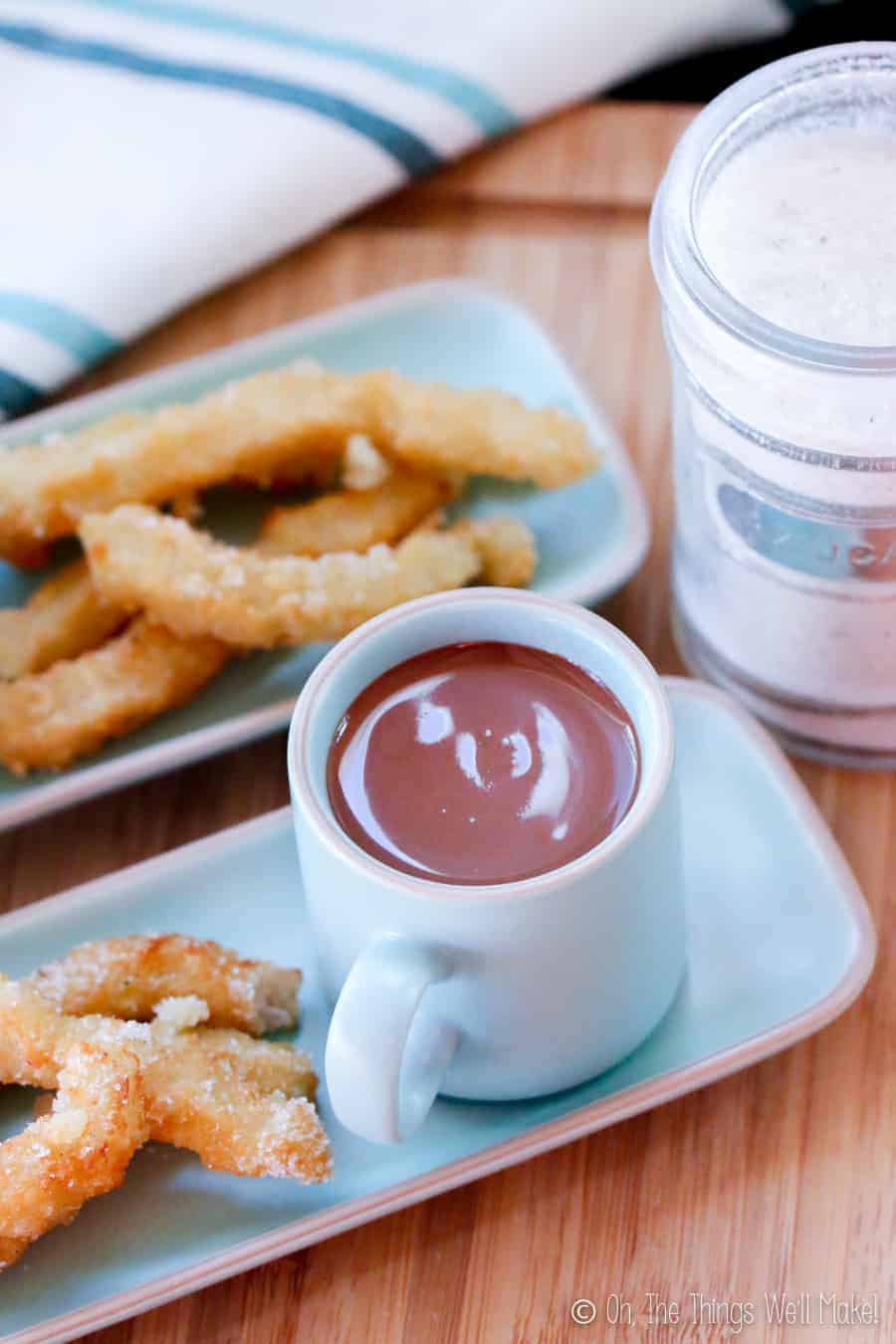
Perhaps the most well known Spanish party food, churros, over the years, have been enjoyed and adapted by people from all over the world.
In Spain, churros are served from mobile churrerías at fairs, flea markets, and fiestas (festivals).
At bars, they are served for breakfast with chocolate a la taza, a thick, pudding-like chocolate drink that you can dip your Churros into. These “breakfasts” are often enjoyed by late-night partiers before heading home to bed.
(I may or may not have had churros once or twice, years ago, after a late night at the discoteca.)
Churros & olive oil
In the US, churros are commonly enjoyed covered in cinnamon and sugar, a Latin American adaptation of the recipe.
Here in Spain, though, I’ve never seen them with cinnamon. They instead, get their characteristic flavor from the olive oil in which they have been fried.
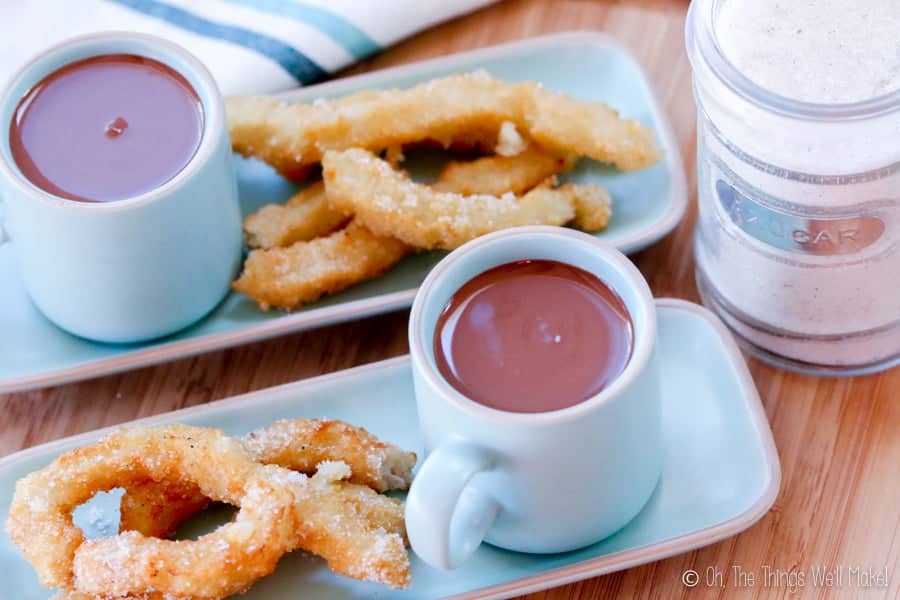
Is it safe to fry in olive oil?
Many people avoid deep-frying in olive oil because it isn’t thought to be as stable as some other fats like ghee, coconut oil, and animal fats. They’re also afraid of it having a lower smoke point than some of the other fats.
The smoke point
A high-quality extra virgin olive oil, though, when not mixed with other oils, actually has a high smoke point (around 405°F). In fact, its smoke point is comparable to that of coconut oil (350°F) and lard (390°F).
The vitamin E and antioxidants in extra virgin olive oil also make it quite stable against oxidation.
For those reasons, many people are changing their minds about frying in EVOO.
That said, I’d like to give my take on this subject.
Those of us who are serious about our health won’t be deep frying or making a recipe like this one every day. This recipe should be an occasional treat.
In the case of this recipe, the choice of oil is important because olive oil gives a distinctive flavor.
If you are going to make them, I’d suggest making them the “right” way. Make these churros and enjoy them as they were meant to be enjoyed. Don’t feel guilty about having an occasional treat.
Of course, it’s up to you to choose the oil that you want to use for frying.
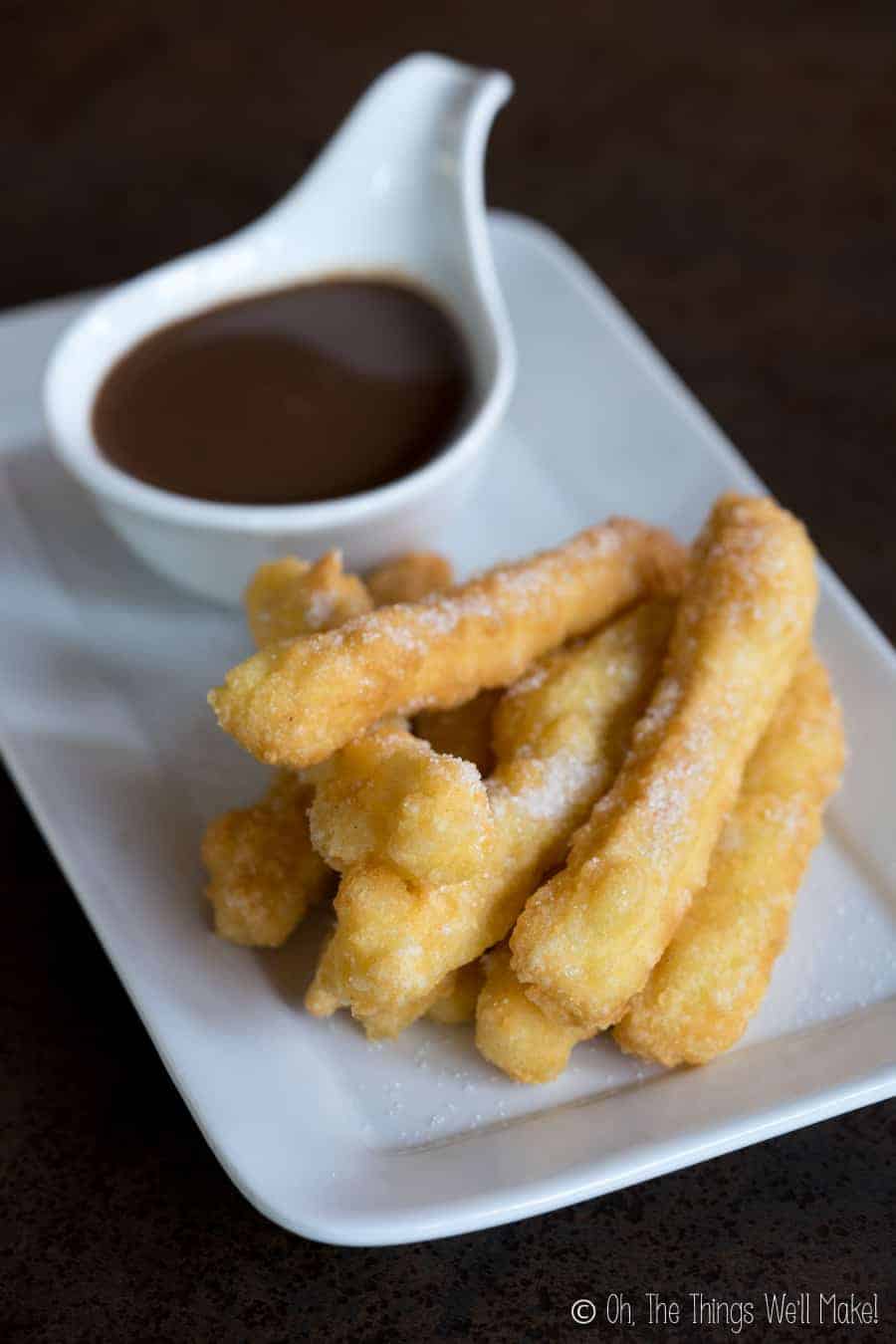
A grain-free, gluten-free dough
Traditional churros are normally made with a simple, thick dough made with flour and water. Modern recipes often use a choux type dough that incorporates milk, butter, and/or eggs. I have shared how to make it either way in my easy churros recipe post.
Coming up with a grain-free version was actually trickier than I thought it would be. I tried different combinations of tapioca flour, almond flour, and coconut flour, with various results. I’m almost embarrassed to say how many batches I made throughout the process, so I won’t. 😉
Using tapioca starch
Tapioca starch or flour has an interesting property that makes it a great choice for making grain-free or gluten-free adaptation recipes. When you heat it, it achieves an elastic texture that helps hold the dough together almost like gluten does.
To achieve this elasticity, though, the flour and water mixture needs to be very hot. That’s why it’s especially important in this recipe to add the flour immediately after reaching the boiling point of the water. Measure out the flour ahead of time, ready to be added to the hot water.
If you find that the dough is runny or not achieving an elastic-like texture, it’s probably because the temperature wasn’t high enough. To fix the problem, you can try heating the mixture over low heat, but be careful not to completely cook the dough either.
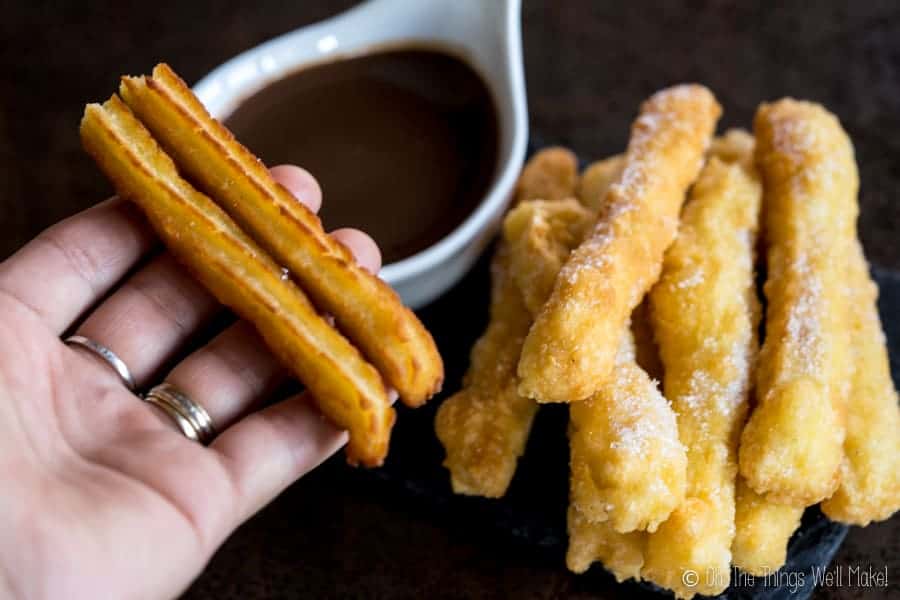
Importance of order
So, we’ve already established that the tapioca starch needs to be added immediately after removing the water from the heat source, but the coconut flour is also a bit finicky.
When making these churros, I measure out all 3 flours ahead of time. Once the water reaches its boiling point, I remove it from the heat source and immediately mix in the coconut flour.
Coconut flour absorbs a lot of water and it’s easiest to incorporate it first. Work quickly, though, as you need to immediately begin to add the tapioca starch.
To help avoid getting lots of lumps in the dough, I add the tapioca starch a little bit at a time, stirring quickly and vigorously and immediately adding more.
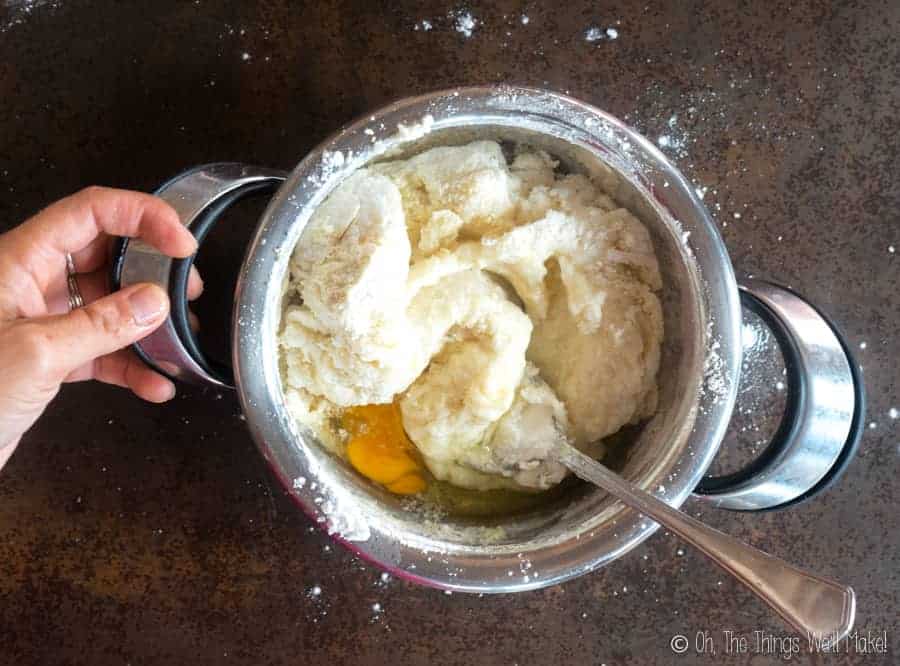
Once the tapioca starch is fully incorporated, you can add the almond flour. The dough will be very thick and elastic by this point, so it may be difficult to completely blend it in with the other ingredients.
Adding the egg will slightly soften the dough and will allow you to fully mix all the ingredients together.
Piping out the dough
When I first shared this recipe, I made a lighter dough that didn’t hold together quite as well. (It included another egg and slightly more water.) That dough needed to be piped directly into the hot oil because it was too sticky to handle.
I have since updated the recipe to allow for piping the dough out onto a clean cloth where it can be cut to size. The pre-piped dough can then be easily added to the hot oil for frying.
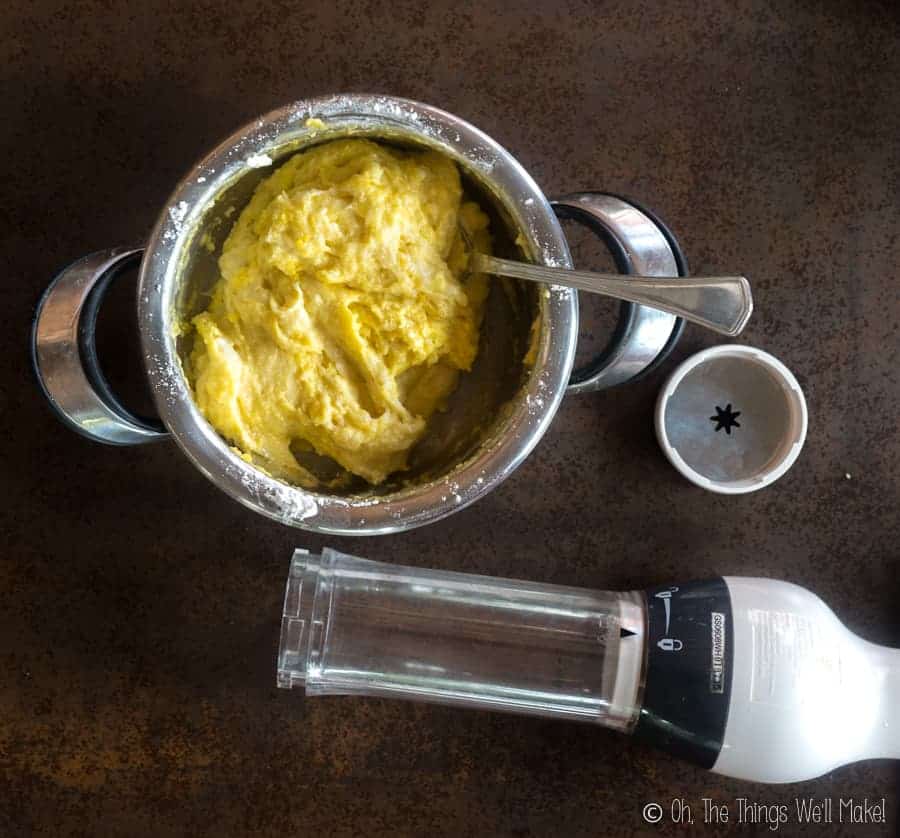
The dough is ready to be added to the cookie press. 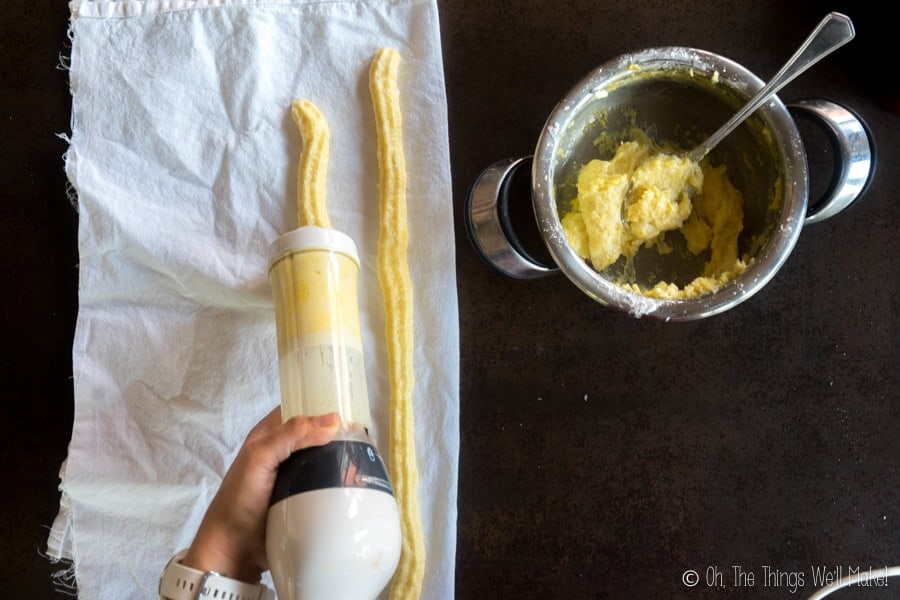
Piping out the dough onto a cloth.
Although you can pipe this dough out onto a clean cloth, it is stickier and not as “pretty” as the dough made with wheat flour.
Differences in frying
The dough of traditional churros is easier to handle and makes prettier churros. It also fries more quickly than these grain-free churros.
When frying these churros, I began frying them at around 190ºC/375ºF. It’s a good frying point that allows them to cook without overheating the oil too much.
I was worried that they were taking way too long to turn a golden brown. What ended up taking only a couple of minutes with the traditional, wheat-based churros, took around twice as long for the grain-free churros.
I was concerned that I may have been cooking the churros too long, but I later found that it was very important to cook these longer. The longer cooking time converts the elastic dough into more of a bread-like, soft interior. If these churros aren’t cooked long enough, the center will be sticky and raw.
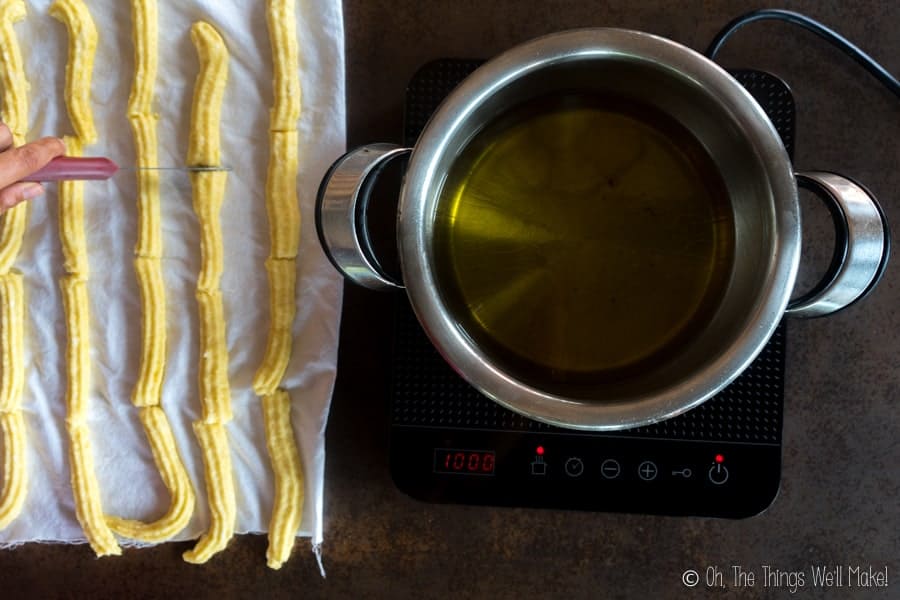
Cutting the churros to size 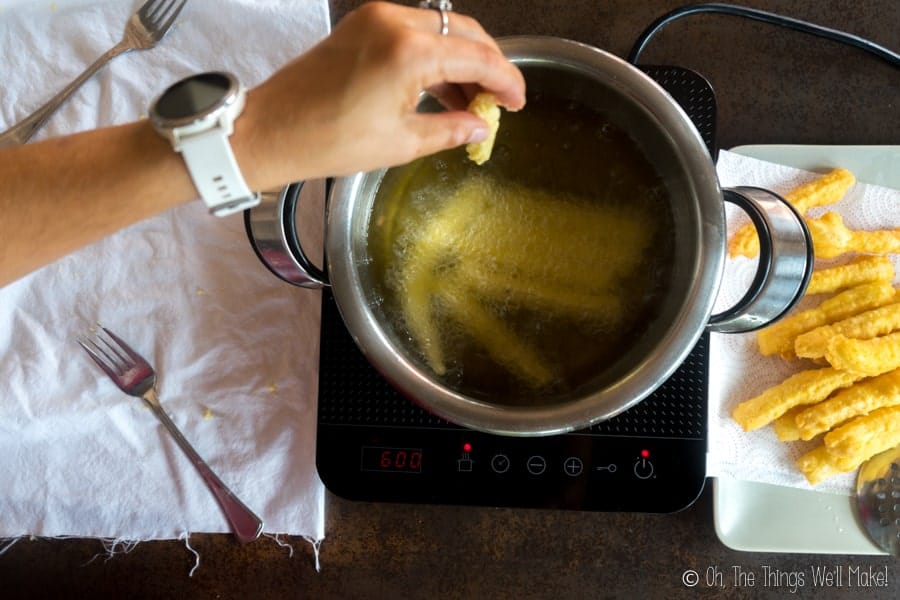
Adding the dough to the hot oil 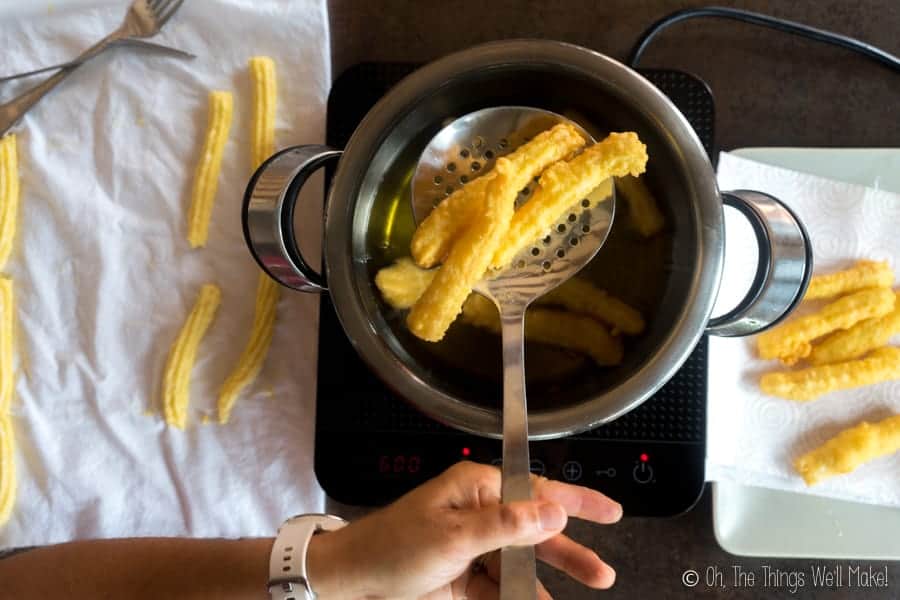
Removing the fried churros 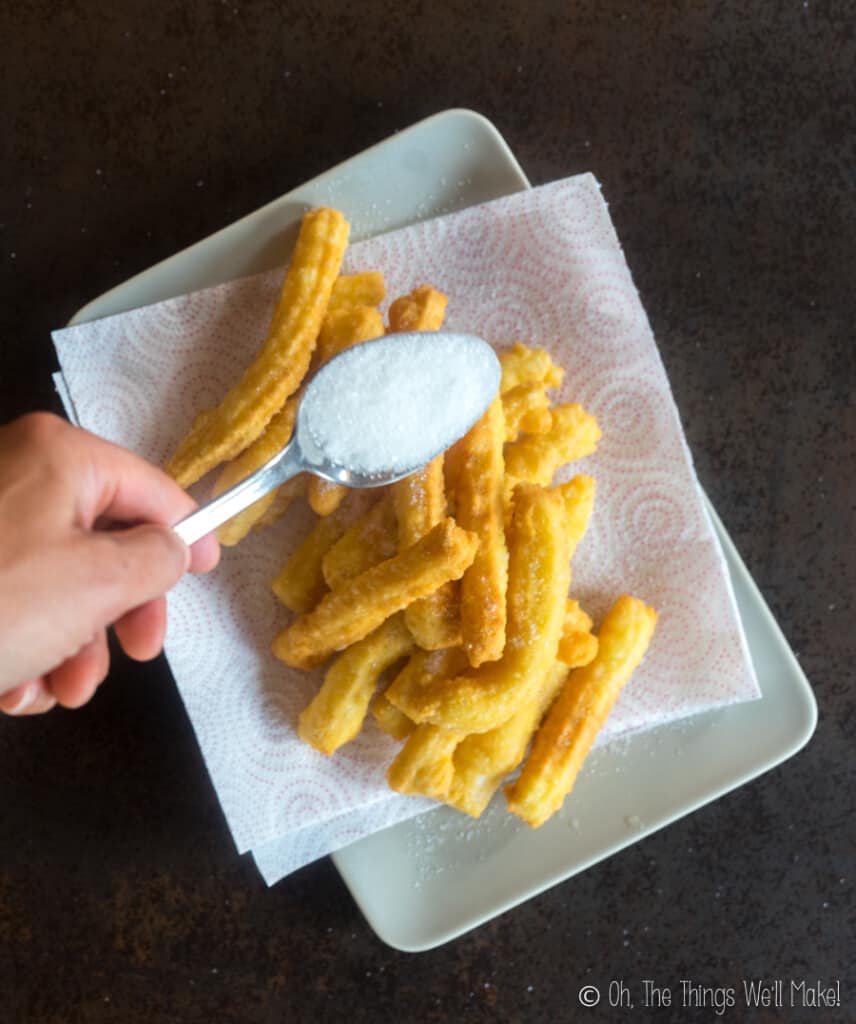
sprinkling the finished churros with sugar.
While the traditional churros can be made to be quite thick, these churros are best when made with a thinner tip or disk.
You may also notice that these may bubble slightly when fried, causing them to form “wart-like” projections on the churros. While they may not be as beautiful as the others, they are still delicious. In fact, my husband liked these better than the ones made with wheat!
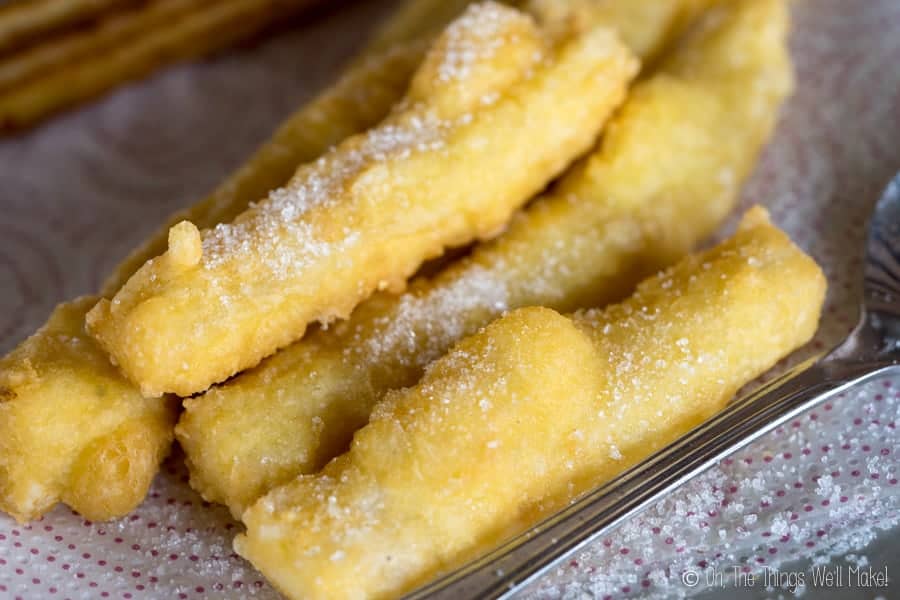
Making vegan grain-free churros
While you can easily sub out the butter for olive oil or coconut oil, I preferred the flavor of these churros when made with eggs.
At first, I had a hard time making the dough without them. I later found, though, that if you are careful about achieving an elastic texture with the tapioca starch, the dough will hold up well without them.
You may have to experiment a bit with the ratio of water: flours to achieve a workable dough, but it should be possible to make vegan grain-free churros that don’t differ too much from these.
Watch how to make grain-free churros
Grain-free, Gluten-free Churros Recipe
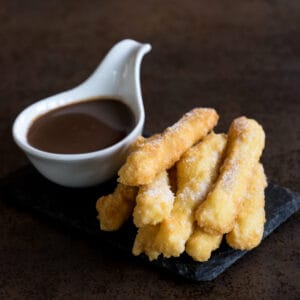
Gluten-free Churros Recipe – Spanish Style
Ingredients
- 1 cup water
- 20 g butter (Or ghee or coconut oil to paleo-fy them)
- 1/4 tsp. salt
- 1 cup tapioca flour
- 1/4 cup almond flour
- 1/4 cup coconut flour
- 1 egg
- extra virgin olive oil for frying
Instructions
- Heat the water, butter, and salt in a pan until it reaches its boiling point.
- Remove the pan from the heat and mix in the flours. I add the coconut flour first, followed by the tapioca starch. Adding the tapioca starch little by little, stirring it in between additions, helps prevent ending up with a lumpy dough. Work quickly, though, as the heat of the water helps begin to cook the tapioca starch and gives it an elastic texture that helps hold the dough together. Finally, add in the almond flour.
- Once the flours have been incorporated into the water, stir in the egg.
You should end up with a thick, sticky batter. - Pre-heat the olive oil (for deep frying) in a pan over medium heat.
- Add the batter to a cookie press or a pastry bag with a star-shaped piping tip. You can also use a special churros dispenser (which is really like a cookie press).
- When the oil has reached a temperature of around 190ºC/375ºF, you can begin to fry the churros.
- Either pipe ropes of the batter directly into the hot olive oil or pipe them onto a clean cloth for easier cutting and frying.
- Deep fry the churros until a medium golden brown. These grain-free churros take longer to cook than traditional churros made with wheat flour.
- Remove the Churros from the oil and drain on absorbant paper or cotton cloths.
- Immediately sprinkle with sugar.
- Serve with chocolate a la taza, if desired, and enjoy!
Notes
- This recipe was updated in October of 2019 to remove one of the eggs and part of the water to make a thicker batter. That allows you to pipe the churros onto a cloth and later add them, already formed, to the hot oil rather than piping them directly into the oil.
- Nutritional information is calculated for the dough before deep frying. Deep frying generally more than doubles the calorie amount for a food. It will also (obviously) add more fat it.
*This post was originally published on Feb. 16, 2015. It was updated in November 2019 with an improved recipe, new tips and tricks, new method, and video.
 Español
Español
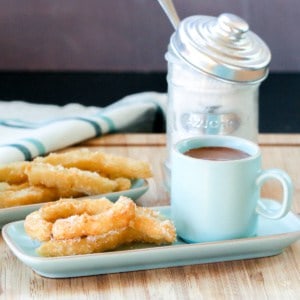
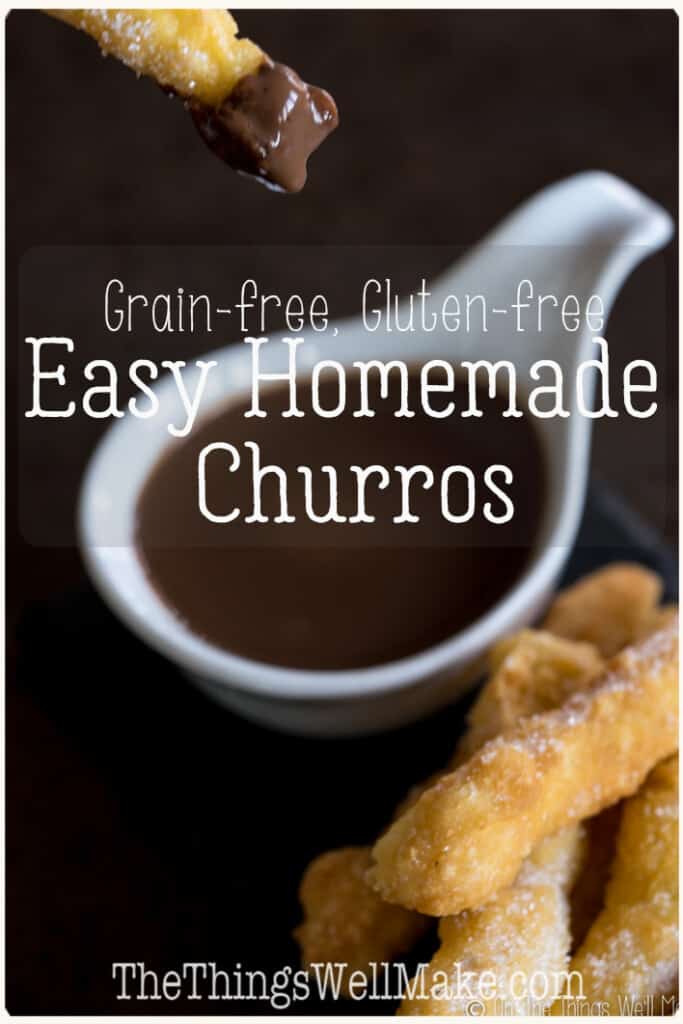
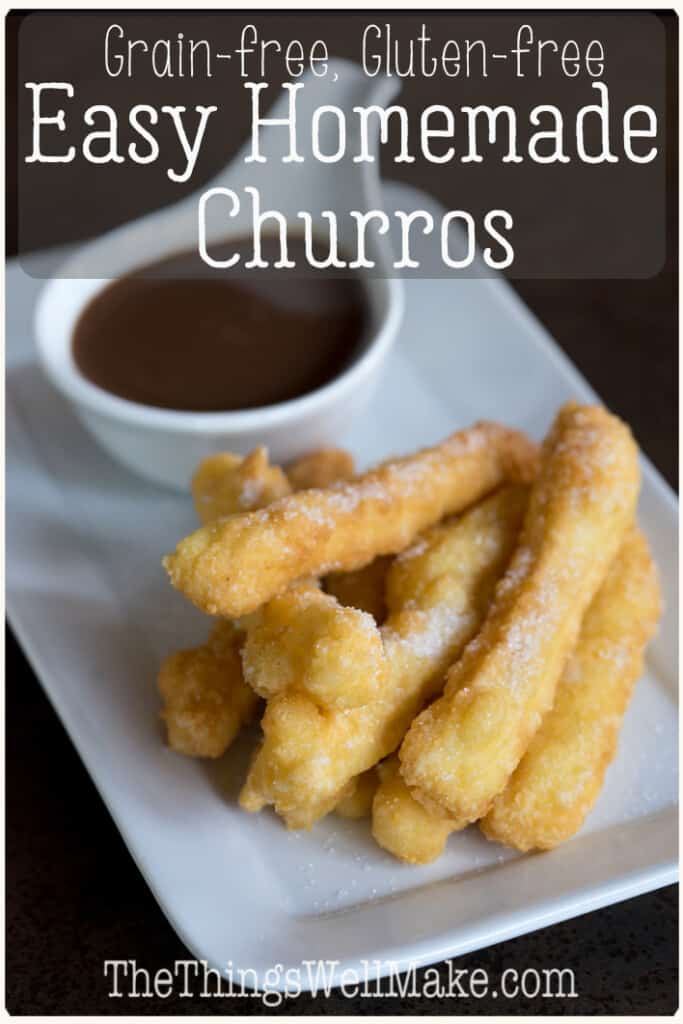
 Easy Spanish Churros Recipe
Easy Spanish Churros Recipe
Ana
Hi, is there any flower I could substitute for the coconut flour due to allergies? Maybe lupine flour or potato starch?
Tracy Ariza, DDS
Hi Ana,
I imagine it should work without problems. I’ve never tried with either so you’d have to experiment, but my best guess is that it shouldn’t be a problem.
Carlos
Hi Tracy,
Thanks for all the replies. My wife tried the recipe in the end, but the mix was waayyy to runny, looked nothing like the images and definitely wouldn’t have worked as batter mix. She added more flour (respecting the ratios), but it continued to be wayy to runny. Can you double check the recipe as it is? I have a feeling the plugin (we changed it to 8 servings) is doing odd things with the ratios…
Tracy Ariza
Hi Carlos,
It sounds to me like it’s a problem with the tapioca starch somehow. When you heat up tapioca starch it goes from runny to thick and sticky.
I say to immediately add in the dry ingredients, because you need to add them when the water is very hot, ideally near boiling. The residual heat from the pan is normally enough to keep things hot enough to get the dough to the sticky consistency that you need, but perhaps with the cold temperatures of winter, your mixture wasn’t hot enough to get the tapioca starch to the consistency it needs to be. If it isn’t, though, you may need to heat the mixture again over low heat (with the flours added), being careful not to cook it too much. It can get pretty solid if you allow it to cook, which may make it almost impossible, if not impossible to form into churros.
I hope that helps. Let me know if you think you are having a different issue, but the recipe looks correct to me.
Carlos
Hi Tracy,
Another question. You say this recipe is for a serving of four. Is that four churros? Four people? Can you just confirm…assume its four churros, right?
Tracy Ariza
Hi Carlos,
Sorry to take so long to get back to you. I’ve been out for the last few days and haven’t been able to get to the computer.
To be honest, I don’t remember how many churros I made, but it’s something that really depends on the size churros you make. I think I made quite a few more than 4, but can’t remember. It’s been awhile since I’ve made them.
My recipe plugin automatically puts in “4 Servings” if I don’t specify. I try to remember to specify the servings if I can in the newer recipes, but in the older ones, they were automatically converted to the new system and all of those recipes will say 4 servings automatically. I asked the developers if that could be removed, especially for the older recipes, but they told me it couldn’t be done. I otherwise like the plugin because it does allow for easy doubling or halving of recipes, conversion to metric, etc.
In any case, 4 servings in this case may not be that far off. It may have very well been around 8 small churros, which would be around 2 per person. All of that, again, is really dependent upon the size you make the churros. Sorry I can’t be more specific, and I hope that helps.
Carlos
Exactly how many churros does this recipe make?
Carlos
Hi,
Quick question, could they be frozen either before or after being cooked?
Tracy Ariza
Hi Carlos,
I personally haven’t tried it with this recipe, but I imagine that freezing the piped dough would probably work. They sell frozen piped out dough here in Spain for easy to make at the last minute churros.
If you do try it out, I’d love to hear how it goes.
Yvonne ballester
Hi tracy my name is yvonne my mum used t make a cake called awella .
bone in gibraltar live in england all my life she will always make this cake
at christmas tried t make it always came out like crumble if u could find
this recipes for me i would be most gratefull; my mum friend gave me
the recipe but it dose not come out right .
thank you yours faithfully yvonne.
Tracy Ariza
Hi Yvonne,
I know how frustrating that can be! I wish I knew how to make a type of beef that my grandfather used to make.
I tried doing a google search to try to find what sort of cake you are referring to, but I can’t find anything about it. Without more information, I wouldn’t even know how to begin to try to help you out!
Even with the recipe, though, it’s sometimes hard to get things to turn out exactly how somebody else makes it. There are so many factors involved- how someone measures, if someone adds in more ingredients or makes their personal changes to the recipe, even the weather can make things turn out differently!
I wish I could be more help.
Carlos
You’re looking for Tarta de la Abuela (Grandmother’s cake)…
Luciane
hello!
I would love to make the churros, but I can’t see the amounts of the ingredients. Is it a problem on my side? Thank you!
Tracy Ariza
Hi Luciane,
I’m so sorry about that. Thank you for bringing the problem to my attention!
I just switched to a new recipe plugin for my blog, and I seem to be having problems with it saving my revisions.
When I had first written out the recipe, I had only written out the ingredients by memory while out for coffee, and I didn’t fill in the quantities.
I went home and fixed it before publishing the post, but for some reason my revisions weren’t saved.
The problem should be fixed now. I hope the recipe works out well for you!